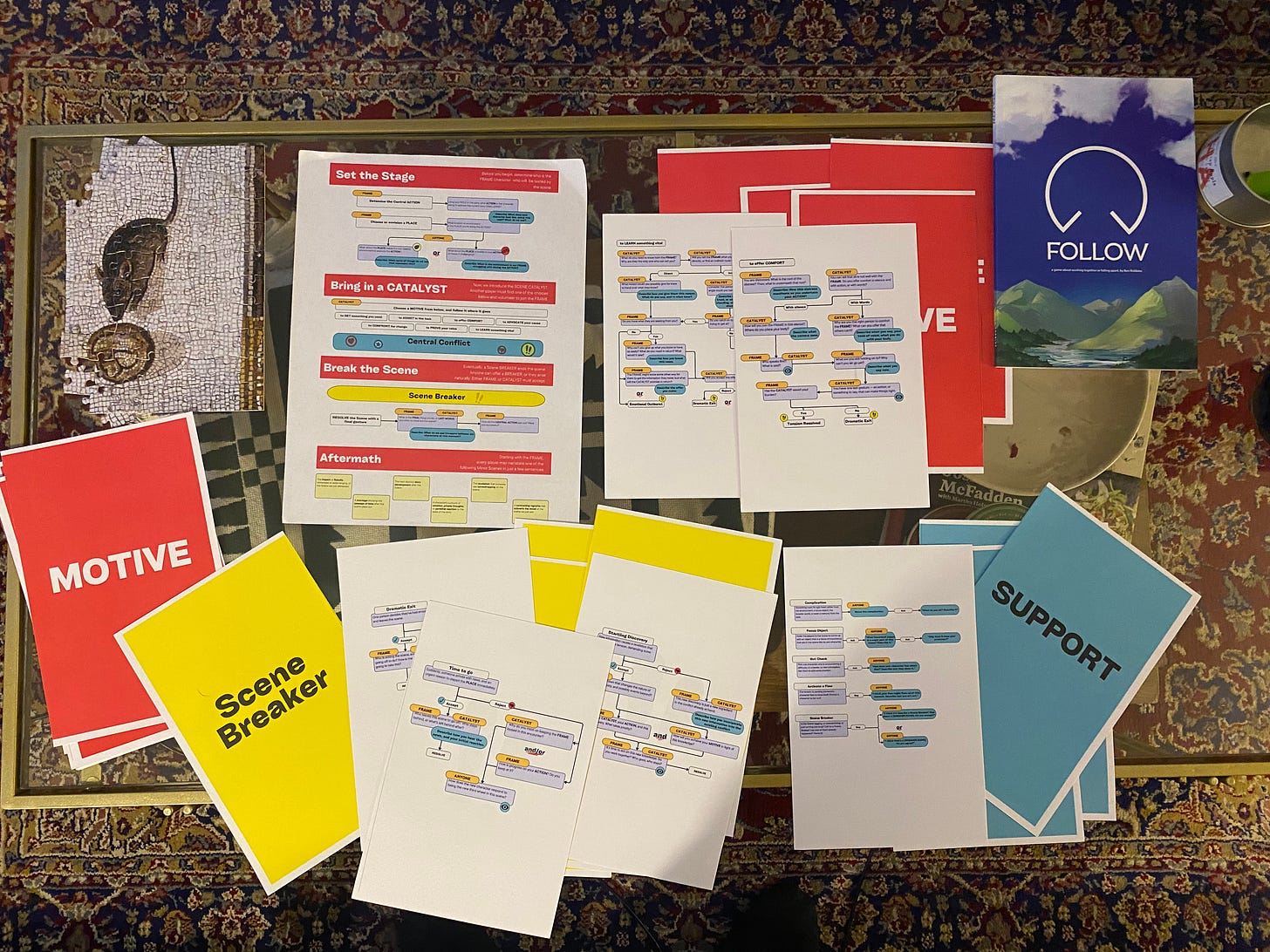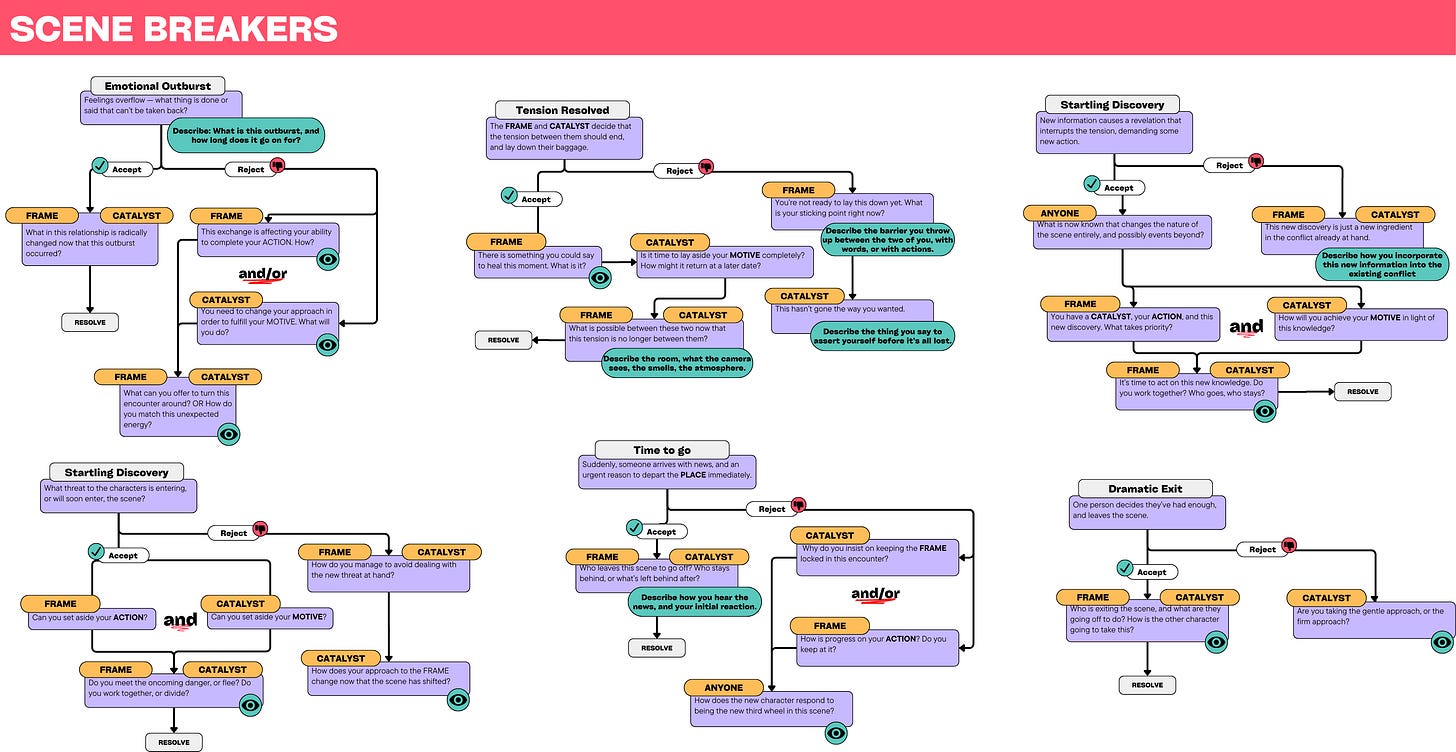Putting together the Scene Kit and boiling it waaaaay down
I messed up, but I've got a good fix already.
Making Great Scenes at your Game Table — a series
Preface: Everyday gamers don’t always know how to make great scenes
Ending out scenes with ‘Scene Breakers’ and resolving the scene
Adding ‘Minor Scenes’ to add action and movement to our story
The Scene Kit, distilled down to one page!
If everything you need to use at once doesn't fit on a two-page spread then it's too complicated. -Chris McDowall, The Bastionland Manifesto
If you’ve been following along, I’ve been trying to find a comprehensive, idiot-proof way of teaching ordinary gamers how to inject cinematic, charater-driven, dramatic scenes into any TTRPG. And if you’ve been following closely, you might have noticed my problem already. You see, in trying to be “comprehensive” and “idiot-proof,” I made something way way way way too big.
When I put it in front of my players, either to review or actually run, it works. There’s the good news: my playtest works!
However, everyone found it just way too much process, by sheer amount. It wasn’t complicated, per se, just brutally involved. Wherever it should have asked one question, it asked three. Even taking it slow, our narration of the scene rapidly outpaced our progress on the flowchart.
I mean, Christ almighty, there’s so much to it! Remember, to Set the Scene, we start with a Frame character who is in a place, doing a thing. Good. Then the other character, the Catalyst, picks a motive, and I’d written a flowchart for each motive! Here’s what that looks like:
God, will you look at all that? And you saw the cards I printed out in the first image! It’s so much paper! Yikes!!
Same thing goes for the six Scene Breakers:
It’s just too much. So let’s try to boil down a bit where we can.
Boiling down MOTIVES
Remember, we have six MOTIVES total. But making a custom flow-chart for each of the six motives really just made me realize how similar they are in structure. They all essentially boil down like this:
Flesh out your motive a bit, including the question “Why is this person the only one who can fulfill my motive?”
Choose your approach: subtle or overt.
Describe why the Frame is resistant.
Find a way to escalate the drama.
Will the Frame give you what you want?
Give up, find a new tactic, or resolve the scene.
So forget it, we should still list the six motives, but each one can follow that same basic process.
Boiling down Scene Breakers
The thing about a Scene Breaker is… by the time it’s on the table, it’s already fleshed out. The moment we trigger an “Emotional Outburst,” we’re already describing it. By the time we’re introducing a “Sudden Danger,” it’s been introduced. If someone says “How about my character makes a Dramatic Exit,” we don’t need to go to the flow-chart, it’s already done.
And so boiling down, in this case, means: Skip straight to resolution. That’s it, you choose a Scene Breaker, describe it, and then go to resolution.
Ready? Here’s the entire Process on one page:
There it is in all its glory, the one-page Scene Kit. I’ll probably still keep those other cards around, maybe as the “expanded version?” I just can’t imagine very many people finding it as valuable.
Lastly, what might be the final piece of this series, is the little actions we’re going to offer the off-screen players, and what I’ve made for them is going to go a long way in making scenes feel lively and dynamic. So the entire core of the Scene Kit is the One-Page Process (above), some SUPPORT cards for off-screen players (up next), and then a small zine with more information and guidance.
You might have noticed, I’ve renamed my two central roles to the
FOCUS“Frame” andPARTNER“Catalyst,” names that clarify both of those roles. Thanks to Mike JB and Otaara from Discord for helping me see that this was important to do.My Lovecraftian horror investigation game The Roaring Age is out. You should download it for FREE!







A lot of work had been done in this area for improv comedy. Lots of over lap. Might be helpful. learnimprov.com
Cool to see materials tested at the table and refined after feedback!